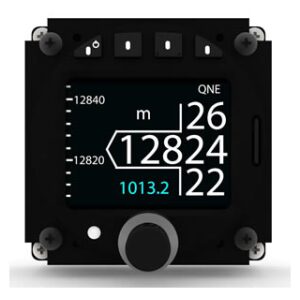Air Avionics Air Control Display
Top-of-the-class display.
- AIR Control Display, or ACD-57 in short, marks the heart of a radio, altimeter or transponder installation.
- It features the industry’s largest display area in a 57mm control head.
- Its stunning color screen is perfectly readable in bright sunlight. Yet it draws very little power.
- The design has been developed and tested to comply to strict aviation standards for multi function displays.ACD-57 can be connected to an aircraft radio, a transponder, or both simultaneously.
- Besides that, it is a fully certified primary altimeter.
- The user interface, that is the display content and the use of controls, automatically adapts to the installation environment for optimum clarity and ease of use.
- Data on the display is kept as large as possible, controls are simple, inuitive, and consistent throughout the entire system.
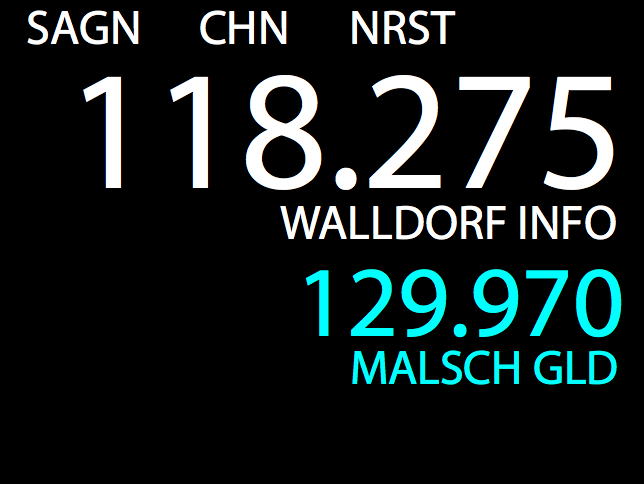

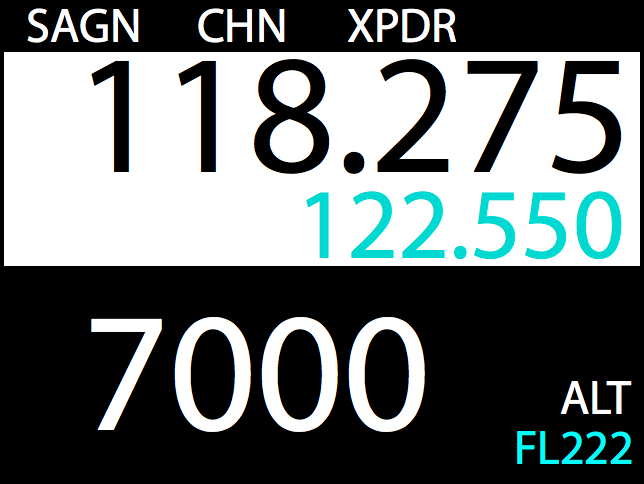
COM Control
If only an aircraft radio is controlled, the active and the standby channel is displayed using very large letters. Additionally, station identifiers can be displayed. The rotary knobs control the volumes (active and standby channel), the rotary knob pushbutton toggles active and standby channel. The pushbuttons on the top of the display trigger commonly used functions such as channel selection (CHN), a nearest station list (NRST), or the “say again” function (SAGN, AIR COM only).
XPDR Control
If only a transponder is controlled, the current squawk code is displayed using very large letters. Additionally the current operation mode (here: ALT) and the transmitted flightlevel are shown.The rotary knobs control the squawk code. The pushbuttons on the top of the display trigger commonly used functions such as operation mode changes (MDE) or the “ident” feature (IDNT).
COM & XPDR
If a COM and a transponder is controlled, data from both systems are displayed using large letters. The rotary knobs control the COM volumes (active and standby channel), the rotary knob pushbutton toggles active and standby channel. The pushbuttons on the top of the display trigger functions such as the “say again” function (SAGN, AIR COM only), channel selection (CHN), or transponder squawk code and operation mode entry (XPDR).
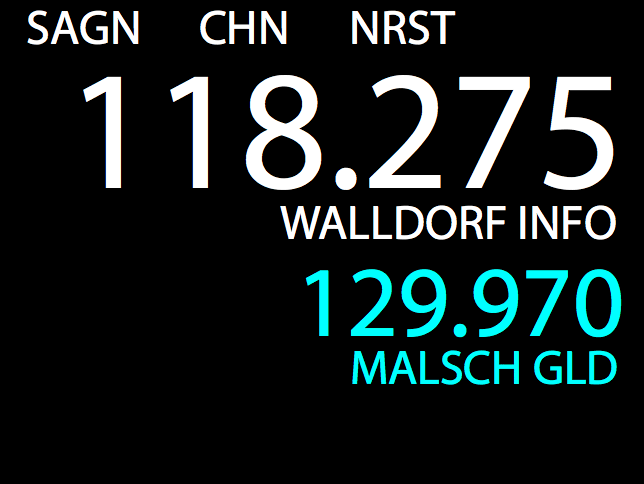
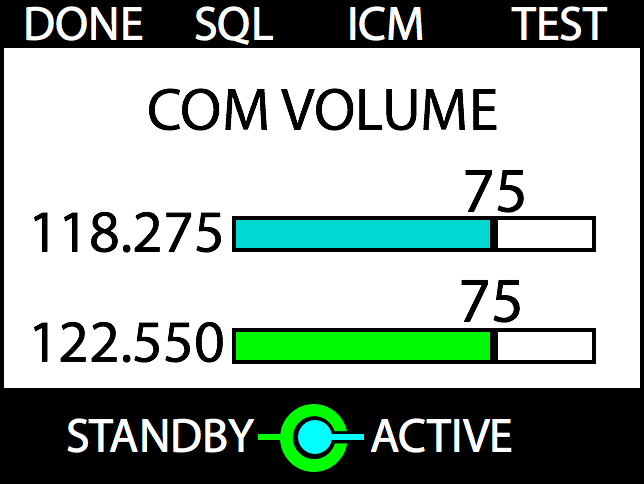
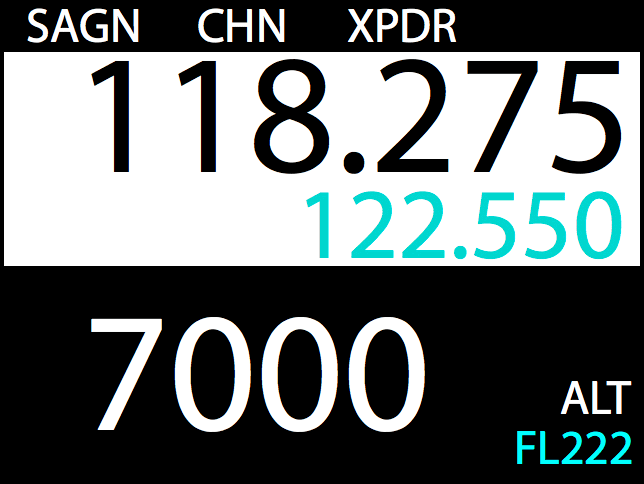
Nearest Channel Selection
Selecting a channel from a close by station is a simple process. First the NRST pushbutton on the top of the display is pushed, then a station is selected with the rotary knob and the selection is executed with a push on the rotary knob pushbutton. The standby channel now has the value of the selected channel. To toggle active and standby, another push on the rotary knob pushbutton is used.
COM Volume Control
Air Control Display is capable of controlling two independent volumes for active and standby channel (available with AIR COM aircraft radio only). You can individually adjust both volumes in order to better differentiate incoming transmissions. The monitoring of the standby channel can be deactivated by setting the standby channel volume to zero.
Entering a Squawk Code
Even if controlling a radio and transponder simultaneously, squawk code entry is easy. With a push on the XPDR pushbutton on top of the display, a menu is opened. The squawk code is entered using the rotary knobs and the entry is executed by a push on the rotary knob pushbutton.
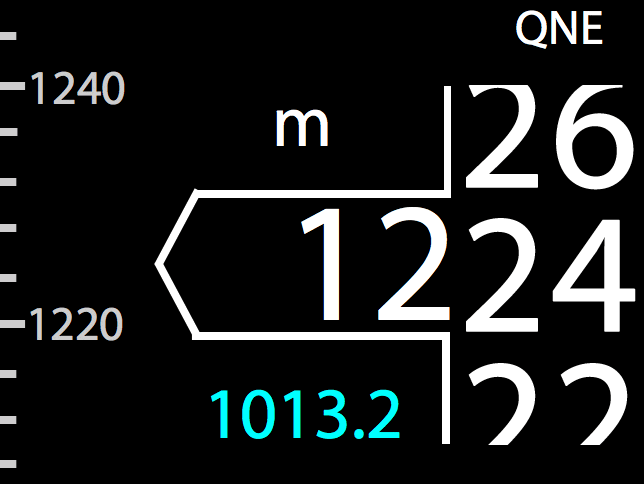
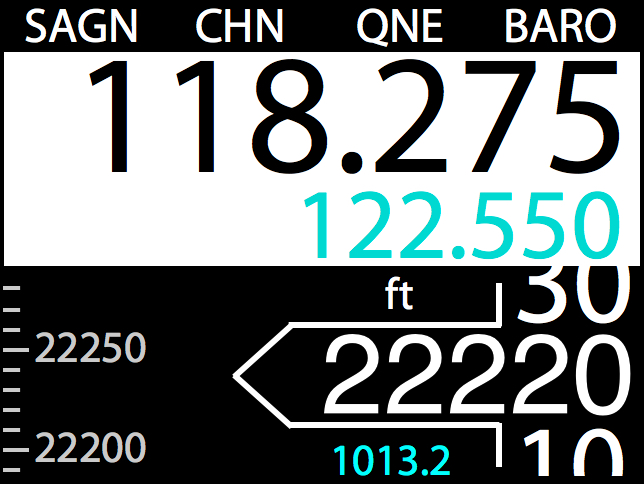
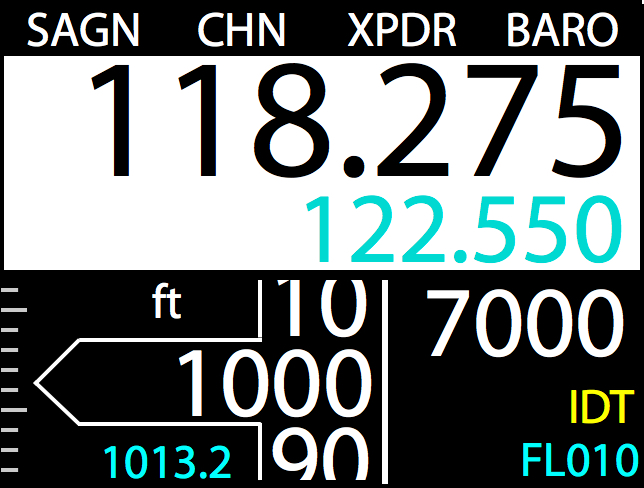
Altimeter
AIR Control Display is fully ETSO certified as a primary altimeter. Without any COM or transponder connected, it can simply be used to show altitude. It is easy to read with really large numbers. It’s tape-style moving digits and its fine altitude resolution give you a great feeling of the current vertical rate. Additionally, its solid state technology is very reliable. ACD-57 by the way is the first altimeter in the world, that is retrofittable with a XPDR or a COM module.
COM & Altimeter
If the altimeter shall be used parallel to COM control, data from both systems are displayed using large letters. In addition to the COM controls, one of the pushbuttons on the top (BARO) triggers the input of the barometric reference, in most cases the QNH or QNE value. Instead of COM control, of course also a XPDR or even both can be controlled in addition to the altimeter function.
COM, XPDR & ALT
AIR Control Display is even capable of controlling COM, XPDR, and displaying (fully ETSO certified) altitude simultaneously on a single display. This is the ultimate choice for applications with minimal panel space. Even though there is lots of information to show, the large, high resolution display helps keeping all the display content large enough to be easily readable.
Innovative Controls
- The functions AIR Control Display provides together with radios and transponders are intuitive and natural.
- We have added some amazing short cuts and helpful functions that make using the system fun and simple.
Select close-by stations
Tuning channels manually
Transponder control
In this video, an ATIS station close to the aircraft’s current position is selected using the NEAREST function. After that, the volume of the standby channel is increased in order to hear the transmissions on this channel (dual watch). This example shows a COM-only configuration.
This video shows how channels are manually tuned in. It is very easy to get from a low kHz value to a high value (in 25kHz steps), then a push-turn gesture is used to “fine tune” (in 8.33kHz steps). In this example, the altimeter is also used in addition to the COM function.
This video shows the control of a transponder. The transponder mode is set to ALT (altitude) with a single click on the mode softkey (MDE). After that a squawk code is manually entered using the concentric rotary knobs. In this example a radio and a transponder are used simultaneously on a single display.
Squawk code shortcuts
Power Consumption
Altimeter
In this video some shortcuts for squawk code entry are shown. A VFR softkey allows for a quick selection of the VFR squawk code (user adjustable). If the VFR squawk code is set, the same key allows to go back to the previous squawk code. In this example a radio and a transponder are used simultaneously on a single display again.
The transponder controls are always shown on the ACD-57, with the ability to always pre-set a squawk code. However, the transponder module is powered OFF, drawing zero power, unless the sending function (mode ALT) is selected. Therefore, one is able to quickly switch the transponder on at any time (takes less than .5s) but it will not draw any power while in standby mode.
The altimeter shows the current altitude in an aviation-standard tape-style indicator with large and easy-to-read numbers. The smooth feel and quick response help understanding the current vertical rate nicely. It can even be used as a not energy-compensated variometer.
Altitude Units
Switching altitude units from [m] to [ft] is as easy as pushing a button. Moreover, it is possible to quickly change the reference pressure from the current value, e.g. a QNH or QFE value set before takeoff, to standard pressure (29.92 inches Hg or 1013.25 hPa) and back to the previous value. This allows for quick changes, for example, while communicating with ATC.

